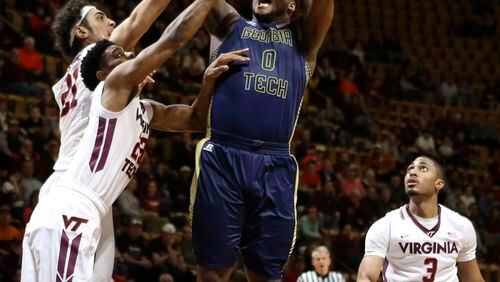Georgia Tech’s play in the final minutes of eight of its ACC games has been, if you’ve been paying any attention, rather costly. The Yellow Jackets have won two games handily (Miami and Wake Forest), lost one by a historic margin (Virginia) and lost two more that the opposition had in relative control in the final minutes (Wake Forest and Duke).
In the remaining eight – Notre Dame (twice), Syracuse, Pittsburgh, Boston College, N.C. State, Virginia Tech and Florida State – the margin was three points or less at the one-minute mark of regulation. The Jackets, going into their Monday night game against Clemson, have lost all eight.
I looked at Tech’s play compared to its opponents’ in those games, comparing the first 35 minutes to the final five (not counting the overtime statistics in the Notre Dame and N.C. State losses).
The shooting percentages speak to what is happening, although I take them with a little grain of salt because of the sample size – Tech shot 39.4 percent in the first 35 minutes and 25.8 percent in the final five minutes. Opponents shot 51.4 percent in the final five minutes of the eight games, compared to 44.7 percent in the first 35, but a lot of that is due to Virginia Tech’s 6-for-7 finish. If that’s removed, the percentage is 42.9 percent.
Each game represents a small sample size, but, that said, the Jackets haven’t had a game where they finished hot from a shooting percentage standpoint (which sort of stands to reason, in that we’re looking at losses).
But, ultimately, the most noteworthy thing to me is this – Tech (barely) outscored the opposition in the first 35 minutes (419-417) but has lost the final five minutes 74-55. (Again, if you take out the horrendous finish of the Virginia Tech game, the difference is 57-50.)
Tech has outscored the opposition in the final five minutes only twice (the first Notre Dame game and Boston College).
But even if you keep the Virginia Tech game, that’s a difference of 19 points over eight games. That’s 2.4 points per game. An inability to come up with a field goal and free throw over five minutes – about eight possessions – is more or less the difference between a hard-to-fathom season and what could have been an entirely respectable one.
The following are two charts comparing Tech and its opponents' play in the final five minutes of regulation in the eight close losses compared to the first 35. The fourth column is the percentage of points scored in the final five minutes of the second half compared to the entire total scored in regulation. (Five minutes represents 12.5 of regulation time.)
Opponent
TECH







